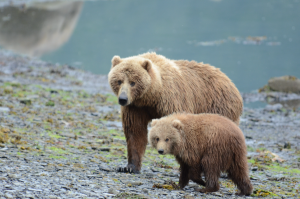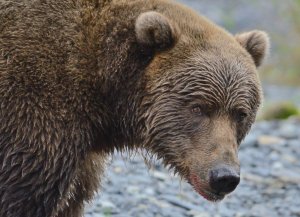My December bear story is more than a bear tale. It describes a memorable 18 hours of my life.
December is a tricky time of year on Kodiak Island. The temperature can be in the forties, winds calm, and the sky clear, but an hour later, it might be 20 degrees with 50 mph winds, snow blowing sideways, and no visibility. A quick flight to town by floatplane can turn into a weeklong ordeal, waiting for the weather to improve enough to fly home.
About 15 years ago, Mike had just such a trip to town. The weather was fine when he left. Our deer hunts had recently ended, and we had deer meat hanging in the meat shed. Mike’s plan was to fly to town, run a few errands, and fly home the next day to process the meat. It had been very cold, so the deer meat in the shed was frozen solid, and we weren’t concerned about it attracting bears. Mike’s trip to town turned out to be longer than expected, though, when a storm hit, and one night turned into two and then three.
I stayed by myself at the lodge, but I wasn’t worried, because everything was working fine. My routine was to turn on the generator in the evening and then turn it off again just before I went to bed. The only inconvenience was that I had to walk 100 feet to the generator shed. The easiest path from the house to the shed is down a wooden walk, but the walk was covered with ice, making it nearly impassable. Instead, I took the longer, safer route behind the house, past the meat shed, and between our two guest cabins.
The third night of staying alone, the temperature soared above freezing, and to my delight, the ice on the walk began to melt. What I didn’t consider was that the deer meat was also thawing. That night at bedtime, I grabbed my flashlight for my trek to the generator shed. I started to head up the trail to the meat shed, but at the last moment, I realized the ice had melted from the walk, so I took that route. Once I was back inside the house, I bolted the door and got ready for bed in the pitch-dark house. Just as I was sliding under the covers, I heard the unmistakable noise of boards being ripped from a building, and the sound was coming from the direction of the meat shed. I considered my options but quickly decided I did not want to confront a bear on a dark, moonless night, so I crawled into bed and pulled the covers over my head.
The next morning, I thought I had imagined the late-night commotion. The shed appeared fine when I looked at it through the kitchen window, but then I saw a fox on the hill behind the shed and then another fox and then three eagles, all eating something. I hurried outdoors and down the walk to get a view of the shed from a different angle, and sure enough, a large section of the rear wall was missing. A bear had busted through the wall, drug the deer meat outside, enjoyed a feast, and now the other forest creatures were feeding on his scraps. I didn’t see the bear, but I knew he probably hadn’t gone far, and as soon as he digested his dinner from the previous evening, he’d be back to search of his next meal. I called Mike and reported the situation, and he told me to be careful and said he’d be home as soon as the weather improved.
The skies briefly cleared in Kodiak, and it looked as if Mike might get home to help me with my bear situation, but as I waited for the plane, it began to snow. Pilots flying around the rugged, mountainous terrain of Kodiak Island must be able to see where they are flying, and heavy snow makes that impossible. I stared out the window as the snow showers continued. At times the visibility was fairly good, and at others, the mountains were completely obscured. I called the airlines and reported our weather, and the pilot was hesitant about attempting the flight. I wanted Mike to get home and help me with the bear, but I did not want him to fly in poor weather.
As I waited, my anxiety built, and when I received a VHF radio call from a deer hunter saying a plane had crashed in the bay, and he was bringing the pilot to our lodge, I was certain it was Mike’s plane. As it turned out, though, the downed aircraft was a wheel plane, and while the pilot was cold, wet, and upset, and the plane was totaled, there had been no passengers on the plane, and the pilot wasn’t hurt.
Mike finally flew home later that afternoon, and the pilot from the crash got a ride back to town. We removed the remaining deer meat from the shed and processed it, and then we repaired the damage to the shed. Once the food supply was gone, there was no reason for the bear to remain, and he went on his way.
I have always wondered what would have happened that night if I’d chosen to take the trail past the meat shed after I’d turned off the generator. I likely would have collided with a hungry bear intent on locating the deer meat he could smell. Maybe he would have run from me, and then again, maybe not. When it was all over, I decided I did not want to spend another December night alone in the wilderness!

















